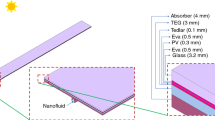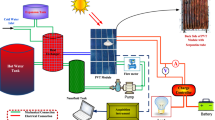Abstract
The aim of the current article is to explore methods for boosting the productivity of PVT (photovoltaic thermal) unit in the presence of dust. This investigation centers on a PVT system comprising a cooling tube equipped with anchor-shaped fins, coupled with photovoltaic (PV) cells integrated with thermoelectric generator (TEG) modules to augment electrical output. To optimize system performance amidst dusty conditions, a hybrid nanofluid consisting of a mixture of water and Fe3O4/SiO2 nanoparticles is employed within the cooling tube. Additionally, a self-cleaning technique is implemented by coating the glass layer with SiO2 nanoparticles to mitigate the impact of dust deposition. The study evaluates the photovoltaic (ηPV), thermoelectric (ηTE), and thermal (ηTh) performances of two structural configurations: case A, without fins, and case B, with fins. Various values of inlet velocity (Vin) and the fraction of additives (ϕ) are investigated to assess their influence on system performance. The utilization of Fe3O4/SiO2–water hybrid nanofluid in PVT cooling tubes is shown to improve heat transfer, stability, and thermal management, thereby enhancing overall system efficiency. Notably, the positive impact of loading hybrid nanoparticles for the structure without fins is approximately three times greater than that for the finned case. In scenarios where dust deposition occurs within case B, reductions in ηPV, ηTE, and ηTh are observed, emphasizing the detrimental effects of dust. However, the application of nanoparticle coatings on the glass of the finned case leads to significant augmentations in ηPV, ηTE, and ηTh, underscoring the efficacy of this approach in maintaining system performance in dusty environments. Specifically, with dust deposition within case B, the ηTh, ηTE, and ηPV reduce by 14.05%, 12.06%, and 38.19%, respectively. Furthermore, the study highlights the influence of Vin on ηPV for both cases A and B, with notable improvements observed when the glass is coated with nanoparticles. Additionally, in the absence of dust, increases in the velocity of the hybrid nanofluid and the installation of fins are shown to enhance temperature uniformity across the panel. Specifically, the augmentation of ηPV with the rise of Vin for cases A and B enhances by about 8.07% and 4.93%, respectively, if the glass is coated with nanoparticles.












Similar content being viewed by others
Data availability
No datasets were generated or analyzed during the current study.
References
Aboelmaaref MM, Zayed ME, Zhao J, Li W, Askalany AA, Salem Ahmed M, Ali ES. Hybrid solar desalination systems driven by parabolic trough and parabolic dish CSP technologies: technology categorization, thermodynamic performance and economical assessment. Energy Convers Manag. 2020;220:113103. https://doi.org/10.1016/j.enconman.2020.113103.
Ibrahim A, Othman MY, Ruslan MH, Alghoul MA, Yahya M, Zaharim A, Sopian K. Performance of photovoltaic thermal collector (PVT) with different absorbers design. WSEAS Trans Environ Dev. 2009;5(3):321–30.
Alktranee M, Al-Yasiri Q, Shehab MA, Bencs P, Németh Z, Hernadi K. Experimental and numerical study of a photovoltaic/thermal system cooled by metal oxide nanofluids. Alex Eng J. 2024;94:55–67. https://doi.org/10.1016/j.aej.2024.03.050.
Menon GS, Murali S, Jacob Elias DS, Aniesrani Delfiya PV, Alfiya MP, Samuel. Experimental investigations on unglazed photovoltaic-thermal (PVT) system using water and nanofluid cooling medium. Renew Energy. 2022;188:986–96. https://doi.org/10.1016/j.renene.2022.02.080.
Kumar S, Kumar R, Thakur R, et al. Effects of climate variables and nanofluid-based cooling on the efficiency of a liquid spectrum filter-based concentrated photovoltaic thermal system. J Therm Anal Calorim. 2024;149:2273–91. https://doi.org/10.1007/s10973-023-12836-4.
Huq M, Jasi AM, Poure P, Jovanovic S, Revol I, Lenoir B. Critical analysis of optimized energy harvesting at small-scale by thermally coupled photovoltaic-thermoelectric systems. Renew Sustain Energy Rev. 2024;195:114331. https://doi.org/10.1016/j.rser.2024.114331.
Narducci D, Bermel P, Lorenzi B, Wang N, Yazawa K. Hybrid and fully thermoelectric solar harvesting. Cham: Springer International Publishing; 2018.
Khenfer R, Lekbir A, Rouabah Z, Meddad M, Benhadouga S, Zaoui F, Mekhilef S. Experimental investigation of water-based photovoltaic/thermal-thermoelectric hybrid system: energy, exergy, economic and environmental assessment. J Power Sources. 2024;598:234151. https://doi.org/10.1016/j.jpowsour.2024.234151.
Kidegho G, Njoka F, Muriithi C, Kinyua R. Evaluation of thermal interface materials in mediating PV cell temperature mismatch in PV–TEG power generation. Energy Rep. 2021;7:1636–50. https://doi.org/10.1016/j.egyr.2021.03.015.
Lekbir A, Hassani S, Saad Mekhilef R, Saidur MR, Ghani A, Gan CKm. Energy performance investigation of nanofluid‐based concentrated photovoltaic/thermal‐thermoelectric generator hybrid system. Int J Energy Res. 2021;45(6):9039–57. https://doi.org/10.1002/er.6436.
Kim C, Perilli S, Sfarra S, et al. Detection of the surface coating of photovoltaic panels using drone-acquired thermal image sequences. J Therm Anal Calorim. 2024. https://doi.org/10.1007/s10973-024-12902-5.
Younis A, Rjafallah A, Cotfas PA, Cotfas DT. Dust impact on electrical and thermal photovoltaic performance: insights from field and laboratory experiments. Energy Rep. 2024;11:2099–110. https://doi.org/10.1016/j.egyr.2024.01.065.
Gürtürk M, Benli H, Ertürk NK. Effects of different parameters on energy–Exergy and power conversion efficiency of PV modules. Renew Sustain Energy Rev. 2018;92:426–39. https://doi.org/10.1016/j.rser.2018.04.117.
Zhou J, Ke H, Deng X. Experimental and CFD investigation on temperature distribution of a serpentine tube type photovoltaic/thermal collector. Sol Energy. 2018;174:735–42. https://doi.org/10.1016/j.solener.2018.09.063.
Khelifa A, Kabeel AE, El Hadi M, Attia MA, Arıcı M, Abdel-Aziz MM. 3D numerical analysis of a photovoltaic thermal using bi-fluid: Al2O3–water nanofluid at various concentrations. Int J Thermofluids. 2023;20:100523. https://doi.org/10.1016/j.ijft.2023.100523.
Khan AA, Danish M, Rubaiee S, Yahya SM. Insight into the investigation of Fe3O4/SiO2 nanoparticles suspended aqueous nanofluids in hybrid photovoltaic/thermal system. Clean Eng Technol. 2022;11:100572. https://doi.org/10.1016/j.clet.2022.100572.
Cui T, Xuan Y, Yin E, Li Q, Li D. Experimental investigation on potential of a concentrated photovoltaic-thermoelectric system with phase change materials. Energy. 2017;122:94–102. https://doi.org/10.1016/j.energy.2017.01.087.
Bisengimana E, Zhou J, Binama M, Yuan Y. Numerical investigation on the factors influencing the temperature distribution of photovoltaic/thermal (PVT) evaporator/condenser for heat pump systems. Renew Energy. 2022;194:885–901. https://doi.org/10.1016/j.renene.2022.05.154.
Hanif H, Shafie S, Jagun Z. Maximizing heat transfer and minimizing entropy generation in concentric cylinders with CuO-MgO-TiO2 nanoparticles. Chin J Phys. 2023. https://doi.org/10.1016/j.cjph.2023.12.021.
Awad M, Ali Radwan O, Abdelrehim ME, Shmroukh AN, Ahmed M. Performance evaluation of concentrator photovoltaic systems integrated with a new jet impingement-microchannel heat sink and heat spreader. Sol Energy. 2020;199:852–63. https://doi.org/10.1016/j.solener.2020.02.078.
Liu L, Jia Y, Lin Y, Alva G, Fang G. Numerical study of a novel miniature compound parabolic concentrating photovoltaic/thermal collector with microencapsulated phase change slurry. Energy Convers Manage. 2017;153:106–14. https://doi.org/10.1016/j.enconman.2017.10.005.
Salari A, Hakkaki-Fard A. A numerical study of dust deposition effects on photovoltaic modules and photovoltaic-thermal systems. Renew Energy. 2019;135:437–49. https://doi.org/10.1016/j.renene.2018.12.018.
Hegazy AA. Effect of dust accumulation on solar transmittance through glass covers of plate-type collectors. Renew Energy. 2001;22(4):525–40. https://doi.org/10.1016/S0960-1481(00)00093-8.
Lu H, Cai R, Zhang LZ, Lu L, Zhang L. Experimental investigation on deposition reduction of different types of dust on solar PV cells by self-cleaning coatings. Sol Energy. 2020;1(206):365–73.
Qiongwan Y, Chan S, Chen K, Zhao B, Ren X, Pei G. Numerical and experimental study of a novel vacuum Photovoltaic/thermal (PV/T) collector for efficient solar energy harvesting. Appl Thermal Eng. 2024;236:121580. https://doi.org/10.1016/j.applthermaleng.2023.121580.
Kraemer D, Poudel B, Hsien-Ping Feng J, Caylor C, Bo Y, Yan X, Ma Y, Wang X, Wang D, Muto A, McEnaney K, Chiesa M, Ren Z, Chen G. High-performance flat-panel solar thermoelectric generators with high thermal concentration. Nat Mater. 2011;10:532–8. https://doi.org/10.1038/nmat3013.
Baranowski LL, Jeffrey Snyder G, Toberer ES. Effective thermal conductivity in thermoelectric materials. J Appl Phys. 2013;113:204904. https://doi.org/10.1063/1.4807314.
Nahar A, Hasanuzzaman M, Rahim NA. Numerical and experimental investigation on the performance of a photovoltaic thermal collector with parallel plate flow channel under different operating conditions in Malaysia. Sol Energy. 2017;144:517–28. https://doi.org/10.1016/j.solener.2017.01.041.
Qinghua Yu, Romagnoli A, Yang R, Xie D, Liu C, Ding Y, Li Y. Numerical study on energy and exergy performances of a microencapsulated phase change material slurry based photovoltaic/thermal module. Energy Convers Manage. 2019;183:708–20. https://doi.org/10.1016/j.enconman.2019.01.029.
Author information
Authors and Affiliations
Corresponding author
Ethics declarations
Conflict of interest
There is no conflict of interest regarding to this manuscript.
Additional information
Publisher's Note
Springer Nature remains neutral with regard to jurisdictional claims in published maps and institutional affiliations.
Rights and permissions
Springer Nature or its licensor (e.g. a society or other partner) holds exclusive rights to this article under a publishing agreement with the author(s) or other rightsholder(s); author self-archiving of the accepted manuscript version of this article is solely governed by the terms of such publishing agreement and applicable law.
About this article
Cite this article
Azizi, E., Khalili, Z. & Sheikholeslami, M. Simulation of solar photovoltaic system integrated with TEG in presence of hybrid nanomaterial. J Therm Anal Calorim (2024). https://doi.org/10.1007/s10973-024-13192-7
Received:
Accepted:
Published:
DOI: https://doi.org/10.1007/s10973-024-13192-7




